All 37 of the framed photographs in the exhibition are drawn from the Johnson Publishing Company Archive, which the museum and the Getty Research Institute jointly acquired in July.
Williams, the son of a Pentecostal minister, said as he looked through the archive that he realized it was full of faith.
“I just was so amazed by how religion was everywhere. And not just Christianity. You had Hebraic traditions, you had Buddhism, you had Judaism,” he said, standing before a display case and speaking to journalists during a Thursday preview. “It was just amazing. And so I knew that there was a story there.”

“Spirit in the Dark: Religion in Black Music, Activism and Popular Culture,” a new exhibition of the Smithsonian’s National Museum of African American History and Culture. RNS photo by Adelle M. Banks
The exhibition’s title, “Spirit in the Dark,” is also the name of an Aretha Franklin 1970 album, highlighting a song she sang in a period of national and personal tumult after the assassination of the Rev. Martin Luther King Jr. Her father was quoted in Ebony in 1971 describing the influence of such songs: “She does with her voice exactly what a preacher does with his when he moans to a congregation.”
The museum has long included facets of religion across its exhibitions — from Harriet Tubman’s hymnal to Aretha Franklin’s “Amazing Grace” album cover, which already is in its Musical Crossroads exhibition two floors above and also is in the new display.
Among the artifacts in the museum’s collection that are on view for the first time is a Bible heavily underlined by Little Richard, placed beneath an album cover titled “Swingin’, Shoutin, Really Movin’ Gospel” that features Little Richard with blues and gospel singer Sister Rosetta Tharpe.
“What I like about his Bible is you could see his wrestling with God, the scribbles and his markings,” said Williams of the singer, who grew up in a Pentecostal tradition. “He wrestled with God and wrestled with Scripture because his community of origin did not affirm his sexuality. And so we see him raising those kind of questions in the margins of his Bible.”

A Bible owned by Little Richard on display in “Spirit in the Dark: Religion in Black Music, Activism and Popular Culture,” a new exhibition of the Smithsonian’s National Museum of African American History and Culture. RNS photo by Adelle M. Banks
Across the exhibition, the varied faiths of African Americans are highlighted as music from a special playlist can be heard featuring artists whose photos are included, from Stevie Wonder to Mahalia Jackson to James Brown.
Sammy Davis Jr. spoke to Ebony in 1960 after surviving a serious car crash and converting to Judaism: “I knew that there was more to reality than the material world,” he said. “Judaism gave me security and understanding.”
There are images of boxer Muhammad Ali and basketball player Kareem Abdul-Jabbar, who both converted to Islam in their 20s — Abdul-Jabbar to Sunni Islam and Ali to the Nation of Islam.
In the “Lived Realities” section of the exhibition, which looks at how artists and activists combined faith with their work, one display notes that Maya Angelou’s writing tools included a pen, a pad and a Bible.
“I believe it is faith which allows human beings to try to rise in the morning, after evenings of terror and fear and grief and disappointment,” Jet quoted her as saying in 1992.











